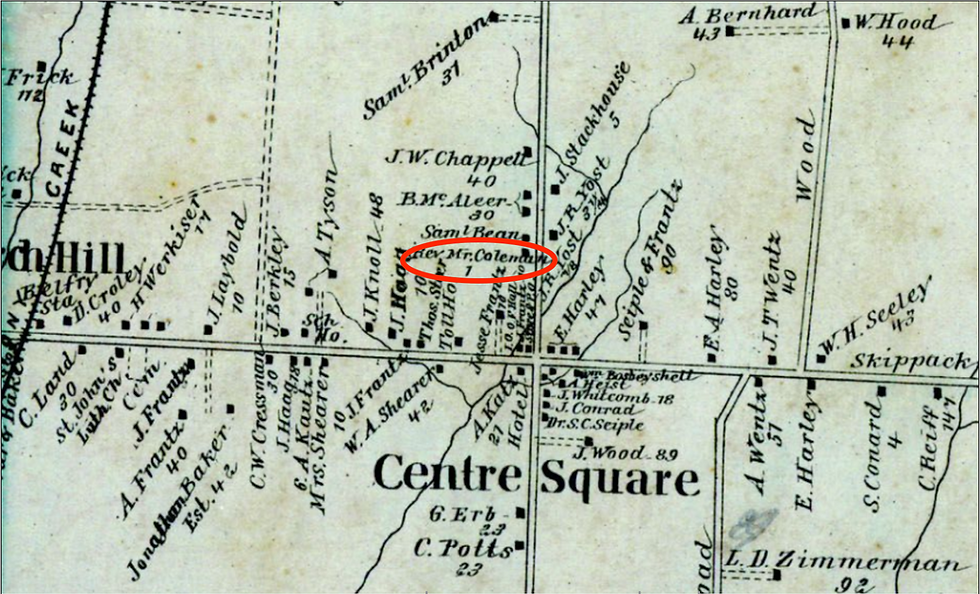St. John's Lutheran Church
- Yen Ho
- Jul 6, 2023
- 3 min read
The St. John's Lutheran Church came into existence after the establishment of Boehm's Church. Deep inside its history is worth exploring, like where did the name "Grog Hill" come from?
Early History

The creation of the St. John's Lutheran Church started from its mother church, the St. Michael's Evangelical Lutheran Church in the Germantown section of Philadelphia. During the 18th century, Germantown had a population of only 300-400 people, many of whom were German Lutherans. The German Lutherans of Germantown built their first church, the St. Michael's church, around the 1730s, and secured their first pastor in 1741.
The congregation expanded outside of Philadelphia, establishing churches in Barren Hill (1752), Upper Dublin (1752-54), Centre Square (1769), and North Wales (1772-75).
Prior to establishing a congregation in Centre Square, the people worshiped in private homes and barns, and traveled on horseback to either Trappe or Germantown to "hear the word of God." The deed for one acre of land was given to George Castner, wife of Philip Boyer, and George Berkheimer. The building of the church was not finished until June 28, 1773.
The building committee conveyed the land to Abraham Shenberger, Leonard Berkheimer, and Philip Hoffman who were the trustees of the Lutheran congregation.
The church's first pastor was Reverend Johann Frederick Schmidt, and he was only 20 years old when he came to the St. John's church. He spent 17 years with the St. John's church where 105 people were welcomed by him.
Fun Fact #1: Rev. Schmidt showed support to the American cause after the British captured Philadelphia. His support to the patriots made the British upset. They used his church in Germantown (St. Michael's) as a barrack: they destroyed his pulpit and organ, defaced the pews, occupied the parsonage, and looted his furniture.
During the 19th century, the St. John's church was rebuilt in 1834, modeling after the St. Michael's church after it was torn down and rebuilt in 1819. The idea of rebuilding the church came from a progressive pastor who was called in to the pulpit in 1829: George Heilig. Unaware of the financial difficulties of the community, he was motivated to have a new church built.

The Story of the "Grog Hill Church" name
During the construction of the new St. John's church, a group of men were sent to retrieve refreshments for the team. After gathering them from the Waggon Inn, they were in a hurry to go up the hill without caring about transporting the refreshments carefully. This resulted in the tail board of the wagon slipping its moorings, spilling all the refreshments out of the wagon, giving the name, "Grog Hill."
After the incident, the members of the church and the pastor were so embarrassed they painted in black letters the name, "Church Hill." But, the name painted hugely did not help the people move on from the embarrassing name "Grog Hill Church."
The Church Revival!
After the church was built, the church was "financially embarrassed," unable to meet the demands of its creditors, resulting the sale of the church under the "sheriff's hammer." Rescue was assured when John Miller and Charles Hallman visited every member of the congregation and gave them their personal bonds as security for the debts.
It was the year 1843 the church members thanked the two men and freed the church from debt.
A movement was growing in the church community: a singing school was established at the church taught by Nicholas Slough; a growing number of women joined the congregation; hosted fairs and festivals to gain funds.
Bibliography
"About Us." St. John Lutheran Church. Accessed October 15, 2022. https://www.stjohnbluebell.org/about-us.html.
Beck, Clara A. St. John's Lutheran Church, Centre Square in Historical Sketches: A Collection of Papers Prepared for the Historical Society of Montgomery County, Pennsylvania, Volume 5. (Norristown: Historical Society of Montgomery County, 1925): 52-72.
Friedman, Stacia. "Historic Church in Mt. Airy Blessed With Preservation." Hidden City Philadelphia. Last modified March 4, 2021. https://hiddencityphila.org/2021/03/historic-church-in-mt-airy-blessed-with-preservation/.




It was not unusual for the German Reformed and Lutheran churches to share a building. The Old Church at Union meeting and Hoover roads was built in 1820 replacing an older building. Since the road is called Union Meeting Road, it is possible that site was the original location before Boehms and St. Johns were built. I was told by a member of the Union Meeting church that there were once records in the attic claiming that the church was used as a hospital after the battle of Germantown, and that there are soldiers buried in the graveyard. I have not been able to confirm this.